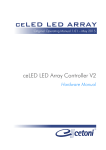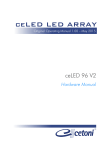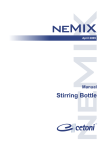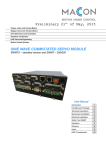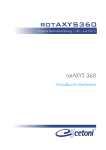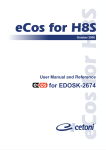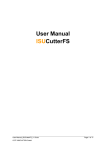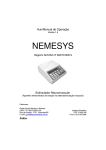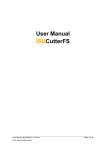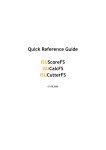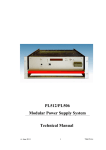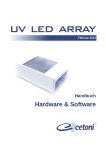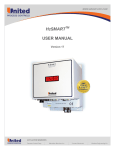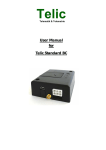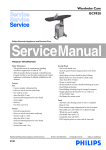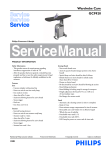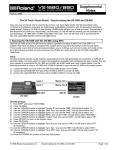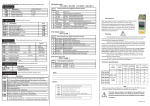Download Hardware Manual
Transcript
Original Setup and Operating Manual 2.01 – May 2015 neMESYS OEM Hardware Manual The information and data contained in this document are subject to change without prior notice. No part of this document may be copied or transmitted without the express consent of cetoni GmbH, irrespective of the means used for this purpose – electronic or mechanical. The general terms of cetoni GmbH apply. Agreements deviating from these terms must be made in writing. Copyright © cetoni GmbH – Automation and Microsystems. All rights reserved. 2 neMESYS Hardware Manual Software License The software and the supplied documentation are copyrighted material. By installing the software you accept the terms of the licensing agreement. License Agreement cetoni GmbH grants the buyer the simple, non-exclusive and non-transferrable right to use the software on a single computer or networked computer system (LAN). Copying or any other duplication of the entire software or parts thereof or mixing and connecting it with other software products is expressly prohibited. For backup purposes the buyer may create a single copy of the software. Cetoni GmbH reserves the right to alter, develop, improve or replace the software. Cetoni is not obligated to inform the buyer with respect to modifications, new developments or improvements or to supply them to him. Cetoni does not legally warrant any particular software properties. Cetoni is not liable for any damage, unless it is caused willfully or due to gross negligence on the part of cetoni GmbH or its agents. Any liability for indirect, incidental or consequential damage is excluded. neMAXYS Hardware Manual 3 cetoni GmbH Wiesenring 6 D- 07554 Korbussen Germany Tel.: +49 (0) 36602 338-0 Fax: +49 (0) 36602 338-11 E-Mail: [email protected] Internet: www.cetoni.de 4 neMESYS Hardware Manual 1. Overviews and Indexes 1.1. Content 1. Overviews and Indexes ................................................................... 5 1.1. Content .................................................................................................... 5 1.2. Revision History ....................................................................................... 8 2. Introduction ................................................................................... 9 2.1. Preface ..................................................................................................... 9 2.2. Symbols and Keywords............................................................................ 9 3. Basic Information ......................................................................... 10 3.1. Standards and Guidelines ...................................................................... 10 3.2. Intended Use ......................................................................................... 10 3.2.1. General Description of the Component ................................................ 10 3.2.2. Proper Use ............................................................................................. 11 3.2.3. Reasonably foreseeable Misuse ............................................................ 11 3.2.4. Safety Measures .................................................................................... 11 3.2.5. Measures for safe Setup ....................................................................... 13 3.2.6. Safe Operation Measures...................................................................... 13 3.2.7. Condition of Devices ............................................................................. 14 3.3. Warranty and Liability ........................................................................... 14 4. Technical Data .............................................................................. 16 4.1. Performance Data ................................................................................. 16 4.2. Dimensional Drawing of Pump .............................................................. 18 4.3. Standard Valve ...................................................................................... 19 4.4. Dimensional Drawing of Valve .............................................................. 19 4.5. Dosing Performance .............................................................................. 20 5. Transport and Storage .................................................................. 21 neMESYS Manual - Content 5 5.1. Transport ............................................................................................... 21 5.2. Maintenance and Care .......................................................................... 21 6. Hardware Operation .................................................................... 22 6.1. Installing a Syringe................................................................................. 22 6.2. Fluidic / Valve ........................................................................................ 25 6.3. Removing Valves ................................................................................... 27 7. Electrical Interfaces ...................................................................... 29 7.1. Overview ............................................................................................... 29 7.2. Power Supply (J1 / J2) ........................................................................... 30 7.2.1. Pin Assignment ...................................................................................... 30 7.2.2. Technical Data ....................................................................................... 30 7.3. CAN Interface (J3 / J4) ........................................................................... 32 7.3.1. Pin Assignment ...................................................................................... 32 7.3.2. Technical Data ....................................................................................... 32 7.3.3. Connecting neMESYS to CAN bus line CiA DS-102 ................................ 32 7.4. RS-232 Connection (J5) ......................................................................... 33 7.4.1. Pin Assignment ...................................................................................... 33 7.4.2. Technical Data ....................................................................................... 33 7.4.3. Connecting neMESYS to a PC ................................................................ 34 7.5. Signal Connection (J6) ........................................................................... 35 7.5.1. Pin Assignment ...................................................................................... 35 7.5.2. Analog Input 1 and 2 (Pin 1 and 2) ........................................................ 36 7.5.3. Digital Inputs 1 and 2 (Pin 3 and 4) ....................................................... 36 7.5.4. Digital Input 7 (Pin 5)............................................................................. 38 7.5.5. Digital Output 1 and 2 (Pin 6 and 7) ...................................................... 39 7.5.6. Digital Output 5 ..................................................................................... 41 7.6. CAN-Bus Termination ............................................................................ 43 7.7. Switching the integrated Valve ............................................................. 43 8. Cable Set ...................................................................................... 45 6 8.1. Power Cable .......................................................................................... 45 8.2. Power Connection cable ....................................................................... 45 8.3. CAN Cable (terminated DSub socket) ................................................... 46 neMESYS Manual - Content 8.4. CAN Cable (DSub plug) .......................................................................... 47 8.5. CAN Connection Cable........................................................................... 47 8.6. CAN Terminator ..................................................................................... 48 8.7. RS232 Cable (DSub socket) .................................................................... 49 8.8. USB-to-CAN Adapter ............................................................................. 49 9. Setup & Cable Connection ............................................................ 51 9.1. Mechanical Setup .................................................................................. 51 9.2. Introduction to Cable Connection ......................................................... 51 9.3. Step 1 – Connecting the Power Cable ................................................... 51 9.4. Step 2 – Data Connection ...................................................................... 52 9.4.1. Introduction........................................................................................... 52 9.4.2. Data Connection through CAN .............................................................. 52 9.4.3. Data Connection through RS232 ........................................................... 53 9.5. Step 3 – Power Supply of additional Modules ...................................... 53 9.6. Step 4 – Data Connection to additional Modules ................................. 53 9.7. Step 5 – CAN Bus Termination .............................................................. 53 10. Disposal ...................................................................................... 55 neMESYS Manual - Content 7 1.2. Revision History Rev Date Modification 1.03 17.08.2010 Creation of Manual 2.00 09.01.2015 Revision for new Hardware 2.01 30.03.2015 RS232 cable modified (DSub jack instead of plug) Added logic table for valve switching 8 neMESYS Manual - Content 2. Introduction 2.1. Preface Thank you for purchasing a cetoni product. With this manual we would like to support you in using the device. For additional questions or comments please feel free to contact us directly. 2.2. Symbols and Keywords This manual uses the following symbols, intended to help you navigate the document: TIP User tips and useful information to simplify the use of the software. IMPORTANT Important information and additional, particularly useful information. This symbol does not refer to dangerous or hazardous situations. CAUTION This symbol signifies a potentially hazardous situation. Failing to avoid it may cause damage to the product or its environment. WARNING This symbol signifies a potentially dangerous situation. Failing to avoid it may cause light or insignificant injury or material damage. neMESYS Manual - Introduction 9 3. Basic Information 3.1. Standards and Guidelines neMESYS OEM-modules conform to the basic health and safety requirements stipulated by the 2006/42/EC machine directive. The modules are incomplete machines according to the 2006/42/EC machine directive and intended for installation into a machine. According to the directive they do not bear the CE mark. Integrating the modules into a machine may cause additional risks. It is imperative that you conduct a risk evaluation of your machine with the integrated modules and take any safety measures necessary. IMPORTANT Please note that you may not use neMESYS OEM-modules until the machine or plant into which the modules are integrated complies with the 2006/42/EC machine directive and the declaration of conformity in attachment II A has been issued. 3.2. Intended Use 3.2.1. General Description of the Component neMESYS devices are syringe pumps. They enable emptying and filling of syringes through a linear relative movement between a syringe holder and a piston holder. The OEM-module is not a complete machine as defined by the machine directive, but an incomplete machine intended for installation into another machine or 10 neMESYS Manual – Basic Information plant. Please refer to the information provided in chapter 9 of this manual with respect to installation and cable connection. 3.2.2. Proper Use The neMESYS syringe pump system is intended for high-precision and pulsationfree dosing of fluids in a range from nanoliters to milliliters per second. Depending on the device being used, pressures in excess of several hundred bar may be reached. The devices are typically used in a lab-like environment. 3.2.3. Reasonably foreseeable Misuse Using the devices in applications other than the ones intended for them may create dangerous situations and must be avoided. WARNING The devices must not be used as medical devices or for medical purposes. 3.2.4. Safety Measures Operator safety and failure-free operation of the devices can only be guaranteed when using original equipment parts. Only original accessories may be used. Warranty claims are void if damage was caused by using third-party equipment or third-party material. The devices were developed and designed in such way as to largely rule out dangers, if used properly. Nevertheless, you should observe the following safety measures to rule out any residual danger. cetoni GmbH would like to point out the operator’s responsibilities when using the device. Local laws and regulations relevant to using this device must be observed. In the interest of a safe work process the operator and user of the device is responsible for observing all relevant laws and regulations. The devices must not be used as medical products or for medical purposes. neMESYS Manual – Basic Information 11 The device is designed and approved for operation in systems governed by article 4 section 3 or the pressurized devices directive 2014/68/EU. This means that he devices may not exceed a maximum volume of 1 liter. When using group 1 fluids according to article 13 of the pressurized systems directive 2014/68/EU, the maximum allowable system pressure is 200 bar. It is 1000 bar for group 2 fluids. If the “Technical Data” section stipulates different product-specific maximum pressure values, such values must be observed. Particular attention must be paid to not exceeding the pressure range of the respective sensor. The information provided in the “Technical Data” section with respect to the maximum operating temperature must be observed. cetoni GmbH is not liable for potential impacts caused by the user extending the system with peripheral devices in a way that causes one or both of these values to be exceeded. The operator is responsible for becoming acquainted with the aforementioned pressurized systems directive and observing applicable stipulations. Before each operation of the device the user has to ensure that the device is functioning safely and is in proper condition. The user must be familiar with the operation of the device and the software. Before starting operation, the devices and wiring must be checked for damage. Damaged wires and plugs must be replaced immediately. Cables must be routed in such way as to rule out any trip hazards. Do not touch moving parts on the devices during operation. There is a risk of crushing. 12 neMESYS Manual – Basic Information Operating the devices in an explosive environment or with explosive substances is prohibited! Make sure to wear safety goggles during installation work on the device or when you work with corrosive, hot or otherwise dangerous substances. Transport, storage or operation at temperatures below 0°C with water in the fluid channels may cause damage to the devices. 3.2.5. Measures for safe Setup Mechanical and electrical installation of pumps may only be done by skilled personnel. Make sure that all devices are installed in line with local laws and regulations. Please note that, principally, the OEM-pumps cannot be considered fail-safe. You have to ensure that a failing pump will not cause damage to your application by employing suitable safety and monitoring measures. Please note that you are not authorized to repair cetoni devices or components. Make sure that the power supply is not active and cannot be activated while conducting installation or wiring work on the devices. 3.2.6. Safe Operation Measures 3.2.6.1 Electromagnetic Emissions The neMESYS syringe pump system is designed for usage in any facility directly connected to a public supply network that also supplies buildings used for residential purposes. neMESYS Manual – Basic Information 13 3.2.6.2 ESD-Discharge Floors should be wood or concrete or covered with ceramic tiles. If floors are covered with synthetic material, relative air humidity must be at least 30%. 3.2.6.3 Electrical Disturbances Supply voltage quality should be equal to a typical business or hospital environment. 3.2.6.4 Magnetic Disturbances Power lines, including those of other devices, should not be placed near the device or its cables. Mobile two-way radios should be kept at the minimum safe distance from the device and its wiring. 3.2.7. Condition of Devices Despite flawless workmanship, the devices may be damaged during operation. Therefore, you should visually inspect the device components mentioned before each use. Pay particular attention to crushed cables, damaged hoses and deformed plugs. If you find any damage, please refrain from using the devices and contact cetoni GmbH immediately. We will repair your devices as soon as possible. Never attempt to repair a device yourself. 3.3. Warranty and Liability The devices left our facilities in perfect condition and may only be opened by cetoni GmbH. If a device is opened by an unauthorized person, all warranty and liability claims shall be void, in particular those referring to personal injury. The warranty period is 1 year from the day of delivery. Any work done on the devices within this period shall not extend or renew the warranty. cetoni GmbH assumes responsibility for its devices with respect to safety, reliability and function only if installation, readjustment, changes, extensions and 14 neMESYS Manual – Basic Information repairs are done by cetoni GmbH or an authorized party, and if the devices are used in accordance with the user manual. The neMESYS syringe pump system complies with the applicable safety rules and standards. cetoni GmbH reserves all property rights for the relevant wiring, processes, names, software and devices. neMESYS Manual – Basic Information 15 4. Technical Data 4.1. Performance Data Electrical Data Supply voltage VCC (ripple < 10%) 24 VDC Peak current draw at 24 VDC 0.6 A Typical current draw at 24 VDC 0.3 A Inputs Analog input 1 (AI1) resolution 11-bit 0 ... +5 V (Ri = 34 kΩ) Analog input 2 (AI2) resolution 11-bit 0 ... +5 V (Ri = 34 kΩ) Digital input 1 (DI1) +3 … +36 VDC (Ri = 12 kΩ) Digital input 2 (DI2) +3 … +36 VDC (Ri = 12 kΩ) Digital input 3 (DI7) +3 … +36 VDC (Ri = 12 kΩ) Outputs Digital output 1 (DO1) open collector, max. 36 VDC (IL < 50 mA) Digital output 2 (DO2) open collector, max. 36 VDC (IL < 50 mA) Digital output 3 (DO5) push pull, max. 36 VDC (IL < 10 mA) Interfaces CAN CAN_H (high); CAN_L (low) RS232 RxD; TxD max. 1 Mbit / s (standard 1 Mbit / s) max. 115200 bit / s (115200 bit / s) Mechanical Data Weight Dimensions (L x W x H) Attachments 16 approx. 1100 g 310 x 47 x 130 mm M3 screws neMESYS Manual – Technical Data Ambient Conditions Operating Temperature -10 … +45°C Storage Temperature -40 … +85°C Air Humidity Non-condensing 20 … 80 % Sound power level < 70 dB(A) Connections Power on device: two-row pin connector (2-pole type) Molex Mini Fit Jr supply plug connector: two-row socket (2-pole type) Molex Mini-Fit Jr. 39-01-2020 crimp contacts: crimp socket Molex Mini-Fit Jr.TM 444-76-1111 (AWG 18-24) CAN on device: 3-pole plug JST XARR-03V plug connector: 3-pole socket JST XAP-03V-1 RS232 on device: 4-pole plug JST XARR-04V plug connector: 4-pole socket JST XAP-04V-1 Signal on device: 12-pole plug JST XARR-12V plug connector: 12-pole socket JST XAP-12V-1 neMESYS Manual – Technical Data 17 4.2. Dimensional Drawing of Pump 18 neMESYS Manual – Technical Data 4.3. Standard Valve Valve Housing material PEEK Sealing material FFKM (perfluoroelastomer) Media temperature 0 to +50°C Max. viscosity 21 mm²/s Internal volume approx. 45 µl Max. pressure 3 bar Rated width 0.6 mm Fluidic connections ¼“ – 28 UNF 4.4. Dimensional Drawing of Valve syringe seals output (normally open) PEEK input (normally closed) CAUTION There is a danger of damaging the housing or sealing material. Before using the valve for the first time, please check the chemical compatibility of the media you want to use with the PEEK housing material and the FFKM (perfluoroelastomer) sealing material. neMESYS Manual – Technical Data 19 4.5. Dosing Performance The following table provides an overview of the minimum and maximum dosing speeds of the various gear configurations as well as the resulting flow rates, using the example of a 1ml syringe with a 60 mm stroke. Speeds and flow rates lower than those referred to as pulsation-free, will cause dosing precision to decrease slowly. Gear Min. speed [µm/s] Min. pulsation-free speed [µm/s] Max. speed [mm/s] 1 ml syringe with 60 mm stroke 20 Min. flow [µl/min] Min. pulsation-free flow [µl/min] Max. flow [ml/min] w/o 14:1 29:1 0.065 0.065 0.065 14.648 1.042 0.502 89 6.33 3.06 0.065 0.065 0.065 14.648 1.042 0.502 89 6.33 3.05 neMESYS Manual – Technical Data 5. Transport and Storage 5.1. Transport Please do not lift or transport the modules in assembled state. Transport in assembled condition is only permitted in the original packaging. Only use the original packaging for transport and shipping. CAUTION There is a danger of damaging the device! Do not transport the modules in assembled condition. 5.2. Maintenance and Care When used properly the device is maintenance-free. Should you encounter problems that you cannot fix yourself or which require opening the device, please contact cetoni GmbH to discuss further actions. The device may only be opened by cetoni GmbH or authorized service staff. Violating this rule will void the warranty. Wipe the device with a moist (not wet) cloth, so that no liquid can drip into the device. In case of heavy soiling you may use a small amount of detergent or alcohol. neMESYS Manual – Transport and Storage 21 6. Hardware Operation 6.1. Installing a Syringe The syringe holder on neMESYS modules allows the use of syringes with outside diameters of 6 to 30 mm and a maximum piston stroke of 65 mm. IMPORTANT Use high-quality glass syringes with outside diameters of 6 to 30 mm to guarantee precise flow rates. Before mounting a syringe on the neMESYS module it needs to be configured and selected in the software. The relevant procedure is described in the software manual. You will need the volume (scale volume), the rated stroke (scale length) and the piston stroke, which may be different from the scale length. Scale Length Scale Volume Piston Stroke Follow this procedure to mount a syringe on the module: Loosen the knurled screw at the syringe holder. You can now slide the bracket out of the pins and lift it up. 22 neMESYS Manual – Hardware Operation Loosen the knurled screw of the piston holder and remove the adapter plate. You can now also lift up the clamping piece. To utilize the entire syringe volume, move the piston holder to its maximum forward position through the software. Place an empty syringe onto the remaining base of the syringe holder in such way that the piston touches the piston holder. The syringe position can be varied somewhat by shifting the piston holder. To do that, loosen the screw with a 4mm Allen wrench. neMESYS Manual – Hardware Operation 23 CAUTION To avoid damage make sure that the remaining syringe stroke is always the same as or larger than that of the module. Screw Now reinsert the bracket of the syringe holder, place it on top of the pins and fix the syringe in position using the large knurled screw. Put the clamping piece back on and insert the adapter plate matching the piston diameter in such way that the piston head sits between the piston holder and the adapter plate. 24 neMESYS Manual – Hardware Operation The piston is fixed in position by slightly tightening the knurled screw in the back. Make sure that syringe and syringe piston are straight and lined up. IMPORTANT Syringes, and seals in particular, are wear and tear parts. Please check them on a regular basis and replace them if necessary. 6.2. Fluidic / Valve The neMESYS module can be fitted with an optional valve. This valve allows you to switch the syringe connector between your application (outlet) and a reservoir (intake), thereby enabling automatic refilling of the syringe. You can use the software to adjust the valve is such way that it switches to the inlet automatically during filling. The three connection points are fitted with a ¼“-28 UNF thread and allow the use of regular HPLC fittings. neMESYS Manual – Hardware Operation 25 Intake (normally closed) Outlet (normally open) Syringe connector A rocker inside the valve (green) connects the syringe connector (1) to the outlet (2) or the intake (3). In the following image the syringe is connected to the outlet (2), while the intake (red) is closed. A FFKM membrane (shaded green area) connected to the rocker seals off the fluidic flow. The membrane also limits the valve’s operating pressure to 3 bar. 2 1 3 CAUTION Please observe the maximum operating pressure of 3 bar to avoid damage to the standard valve. 26 neMESYS Manual – Hardware Operation CAUTION Before using the valve please check the chemical resistance of the PEEK housing material and the FFKM (perfluoroelastomer) sealing material with respect to the fluid you are planning to dose in your application. 6.3. Removing Valves The valve can be removed from the device in a few easy steps. This simplifies the connection of hoses and cleaning, while also enabling you to operate the device without a valve, when not needed. To remove the valve, push the rocker at the plug and pull it off. When replacing it later on, please make sure to face the plug in the correct direction. The white area should face the valve, while the rocker should point away from the valve. CAUTION Please observe the correct placement of the valve plug. The white area should face the valve, while the rocker should point away from the valve. Rocker You can then simply lift the valve to remove it. neMESYS Manual – Hardware Operation 27 28 neMESYS Manual – Hardware Operation 7. Electrical Interfaces 7.1. Overview All interfaces for connecting the device to a power supply, a PC or an external controller are located on the bottom of the device (figure 1). The following interfaces are available: J1 J2 J3 J4 J5 J7 J6 Figure 1 – Electrical Interfaces Connector Interface J1 / J2 Power supply 24VDC In / Out J3 / J4 CAN interfaces In / Out J5 RS232 interface J6 I/O signal interface neMESYS Manual – Electrical Interfaces 29 J7 Shield connection 7.2. Power Supply (J1 / J2) 7.2.1. Pin Assignment Pin No. Signal Description 1 Ground Grounding of supply voltage 2 +Vcc Supply voltage +24 VDC 7.2.2. Technical Data Any power supply can be used, as long as it complies with the following requirements: Power supply requirements Output voltage 24 VDC Output current Depends on power load and number of modules Typical current draw of one module: 0.3 A Surge current draw of one module: 0.6 A Information regarding contacts Plug Molex mini-Fit Jr.TM 2-pole type (39-01-2020) connectors Crimp contacts Molex mini-Fit Jr.TM crimp socket (444-76-1111) Crimp tool Molex crimp tool (69008-0724) 30 neMESYS Manual – Electrical Interfaces neMESYS Manual – Electrical Interfaces 31 7.3. CAN Interface (J3 / J4) 7.3.1. Pin Assignment Pin no. Signal Description 1 CAN_H CAN high bus line 2 CAN_L CAN low bus line 3 CAN_GND CAN ground 7.3.2. Technical Data Standard type CAN high-speed, ISO 11898 compatible Maximum bit rate 1 Mbit/s Protocol CANopen DS-301, DS-402 Node ID Software 7.3.3. Connecting neMESYS to CAN bus line CiA DS-102 neMAXYS CAN 9 Pin D-Sub (DIN41652) Pin 1 “CAN_H” Pin 7 “CAN_H” high bus line Pin 2 “CAN_L” Pin 2 “CAN_L” low bus line Pin 3 “CAN_GND” Pin 3 “CAN_GND” ground Housing “CAN_Shield” Pin 5 “CAN_Shield” cable shield 32 neMESYS Manual – Electrical Interfaces IMPORTANT Please observe the maximum Baud rate of your CAN master The standard Baud rate at the time of shipping is 1 Mbit/s The CAN bus must be terminated with 2 termination resistors (see section 7.6 on CAN bus termination) 7.4. RS-232 Connection (J5) Figure 2 - RS232 connection (J2) 7.4.1. Pin Assignment Pin no. Signal Description 1 neMESYS TxD neMESYS RS232 send 2 neMESYS RxD neMESYS RS232 receive 3 GND RS232 ground 4 Shield RS232 shield 7.4.2. Technical Data Maximum input voltage ± 30 V Output voltage typically ± 9 V @ 3k grounded Maximum bit rate 115200 bit/s (standard 38 400 bit/s) Internal RS232 driver/receiver EIA RS232 Standard neMESYS Manual – Electrical Interfaces 33 7.4.3. Connecting neMESYS to a PC neMESYS RS-232 (JST) PC RS-232 (DSUB) Pin 1 “neMESYS TxD” Pin 2 “PC RxD” Pin 2 “neMESYS RxD” Pin 3 “PC TxD” Pin 3 “GND” Pin 5 “GND” IMPORTANT Please observe the maximum Baud rate of the RS232 interface on your PC or micro controller. The standard Baud rate setting is 115200 bit/s. 34 neMESYS Manual – Electrical Interfaces 7.5. Signal Connection (J6) Figure 3 – Signal interface (J1) “Multi-purpose” digital I/Os and analog inputs are available 7.5.1. Pin Assignment Pin no. Signal Description 1 AnIN 1 Analog input 1 (0 – 5V) 2 AnIN 2 Analog input 2 (0 – 5V) 3 DigIN 1 Digital input 1 “multi-purpose” 4 DigIN 2 Digital input 2 “multi-purpose” 5 DigIN 7 Digital input 7 “multi-purpose” 6 DigOUT 1 Digital output 1 “multi-purpose” / valve voltage 7 DigOUT 2 Digital output 2 “multi-purpose” / valve switching 8 DigOUT 5 Digital output 5 “multi-purpose” 9 GND Digital signal ground 10 +24 VDC Auxiliary voltage 24 VDC 11 +5 VDC Auxiliary voltage output 5 VDC 12 AGND Analog signal ground neMESYS Manual – Electrical Interfaces 35 7.5.2. Analog Input 1 and 2 (Pin 1 and 2) As a standard, analog inputs are defined as “general purpose” and can be configured through the software. AnIN1 Pin [1] AnIN2 Pin [2] A_Gnd Pin [12] Input voltage range 0 ... 5 VDC Max. input voltage 0 … 10 VDC Input resistance typically 34 k against A_GND [12] A/D converter 11-bit Resolution 2.49 mV Bandwidth 250 Hz Figure 4 – Analog input 1 and 2 7.5.3. Digital Inputs 1 and 2 (Pin 3 and 4) “Multi-purpose” inputs can be freely configured and utilized by the user. DigIN1 Pin [3] DigIN2 Pin [4] GND Pin [9] Type of input Single ended 36 neMESYS Manual – Electrical Interfaces Input voltage 0 ... 36VDC Max. input voltage -36 ... +36 VDC Level 0 typically < 0.8 VDC Level 1 typically > 2.0 VDC Input resistance typically 8 k Input current at level 1 typically 270 µA @ 5 VDC Switching delay < 300µs Figure 5 – Digital input 1 and 2 neMESYS Manual – Electrical Interfaces 37 7.5.4. Digital Input 7 (Pin 5) “Multi-purpose” inputs can be freely configured and utilized by the user. DigIN7 Pin [5] GND Pin [1] Input voltage 0 ... 5VDC Max. input voltage -7.5 … + 12.5 VDC Level 0 typically < 0.8 VDC Level 1 typically > 2.0 VDC Input resistance typically 20 k against GND Max. input frequency 2.5 MHz Figure 6 – Digital input 7 “single-ended” 38 neMESYS Manual – Electrical Interfaces 7.5.5. Digital Output 1 and 2 (Pin 6 and 7) 7.5.5.1 Specification Outputs 1 and 2 are used for switching the valve. When the valve is not used the outputs may be free configured and utilized by the user. DigOUT1 Pin [6] DigOUT2 Pin [7] AGND Pin [12] Circuit Open Collector (internal pull-up resistor 2k2 and diode to +5 VDC) Switching delay <3 µs Figure 7 – Digital output 1 and 2 7.5.5.2 Wiring Examples DigOUT “Drain” Maximum input voltage +36 VDC Maximum load current 50 mA Maximum voltage drop <1.0 V @ 50 mA neMESYS Manual – Electrical Interfaces 39 Figure 8 – Digital output 1 and 2 wiring example “drain” DigOUT “Source” Output voltage Uout 5V – 0.75V – (Iload x 2200 ) Maximum load current Iload 2 mA Figure 9 – Digital output 1 wiring example “source” 40 neMESYS Manual – Electrical Interfaces 7.5.6. Digital Output 5 This output is defined as “high speed” and may be freely configured by the user. 7.5.6.1 Specification DigOUT5 Pin [8] GND Pin [9] Circuit Push-pull stage Switching delay <10 ns Figure 10 – Digital output 5 7.5.6.2 Wiring Examples DigOUT “Drain” Maximum input voltage Uin 3.3 VDC Maximum load current Imax 24 mA Maximum voltage drop Udrop <0.55 V + (Imax x 100 ) neMESYS Manual – Electrical Interfaces 41 Figure 11 – Digital output 5 “drain” DigOUT “source” Output voltage Uout 3.3V – 0.75V – (Iload x 100 ) Maximal load current Iload 24 mA Figure 12 – Digital output 5 wiring examples “source” 42 neMESYS Manual – Electrical Interfaces 7.6. CAN-Bus Termination The CAN-Bus must be terminated on both ends with a 120 Ω termination resistor. 7.7. Switching the integrated Valve The integrated valve is switched by digital outputs 1 and 2. Switching of the valve is done through digital output 2. Digital output 1 can be used to lower the voltage during the activated state in order to prevent the valve from heating up due to the coil. The following logic table shows the relevant valve conditions for all possible signal combinations of digital outputs 1 and 2: Dig. Out 1 Dig. Out 2 Valve voltage Valve Coil LED off off voltage less lowered bright Valve state switching 0 0 0 1 1 0 off off 1 1 voltage 24V bright This means that for switching the valve you set both outputs to 1. This switches the valve with the maximum switching voltage of 24 V. If you want to prevent the valve from heating up, switch digital output 1 to 0 after approximately 1 second. This causes the voltage of the coil current to decrease (15 V) and thereby lessens the heating effect. To switch the valve to the other direction simply set both outputs to 0. neMESYS Manual – Electrical Interfaces 43 After turning the device on, both outputs are set to 0. IMPORTANT Activating the coil in the valve for an extended period of time causes the coil to heat up, which, in case of low flow rates, may warm up the medium flowing through the valve. Lowering the valve voltage after switching lessens this heating-up effect. 44 neMESYS Manual – Electrical Interfaces 8. Cable Set 8.1. Power Cable Pins A Signal Pins B - Ground – Power GND 1 + Supply voltage +24 VDC 2 C Shield C Technical Data Cable size 2 x 1.5 mm2 Side A Cable end sleeves 1.5 mm2 Side B Molex Mini-Fit Jr. 39-01-2020 Molex Mini-Fit Jr. crimp contact socket 444-76-xxxx 8.2. Power Connection cable Pins A Signal Pins B 1 Ground – Power GND 1 neMESYS Manual – Cable Set 45 2 Supply voltage +24 VDC 2 Technical Data Cable Size 2 x 1.3 mm2 Side A Molex Mini-Fit Jr. 39-01-2020 Molex Mini-Fit Jr. crimp contact socket 444-76-xxxx Side B Molex Mini-Fit Jr. 39-01-2020 Molex Mini-Fit Jr. crimp contact socket 444-76-xxxx 8.3. CAN Cable (terminated DSub socket) Pins A Signal Pins B Housing CAN shield C 3 CAN GND 3 2 CAN low 2 7 CAN high 1 Technical Data Cable size 3 x 0.125 mm2, twisted pair, shielded Side A D-Sub socket DIN 41652, 9-pole type, with attachment screws, 120 resistor between CAN high (7) and CAN low (2) Side B 46 3-pole socket JST XAP-03V-1 neMESYS Manual – Cable Set IMPORTANT The socket contains a 120 resistor placed between CAN high and CAN low, acting as a CAN-Bus termination. 8.4. CAN Cable (DSub plug) Pins A Signal Pins B Housing CAN shield C 3 CAN GND 3 2 CAN low 2 7 CAN high 1 Technical Data Cable size 3 x 0.125 mm2, twisted pair, shielded Side A D-Sub plug DIN 41652, 9-pole type, with attachment screws Side B 3-pole socket JST XAP-03V-1 8.5. CAN Connection Cable neMESYS Manual – Cable Set 47 Pins A Signal Pins B 1 CAN high 1 2 CAN low 2 3 CAN GND 3 C CAN shield C Technical Data Cable size 3 x 0.125 mm2, twisted pair, shielded Side A 3-pole socket JST XAP-03V-1 Side B 3-pole socket JST XAP-03V-1 8.6. CAN Terminator Pins A Signal Pins B 1 CAN high 1 2 CAN low 2 3 CAN GND 3 Technical Data Termination 120 resistor between CAN high (1) and CAN low (2) Plug connector 3-pole socket JST XAP-03V-1 48 neMESYS Manual – Cable Set 8.7. RS232 Cable (DSub socket) Pins A Signal Pins B Housing Shield 4 5 Ground 3 2 neMESYS TxD 2 3 neMESYS RxD 1 Technical Data Cable size 3 x 0.125 mm2, twisted pair, shielded Side A D-Sub plug DIN 41652, 9-pole type, with attachment screws Side B 4-pole socket JST XAP-04V-1 8.8. USB-to-CAN Adapter neMESYS Manual – Cable Set 49 Pins A Signal Housing CAN shield 3 CAN GND 2 CAN low 7 CAN high Technical Data Cable Size 3 x 0.125 mm2, twisted pair, shielded Side A D-Sub plug DIN 41652, 9-pole type, with attachment screws Side B USB type A 50 neMESYS Manual – Cable Set 9. Setup & Cable Connection 9.1. Mechanical Setup Use the 4 holes (sunk) at the edges of the module’s base plate (see section 4.2 for the dimensional drawing of the pump) to install the module into the front plate of your device. Use M3 bolts for attachment. 9.2. Introduction to Cable Connection Two different cable connections are required for installing neMESYS pumps: 1. Connection of the first module to the power supply and the controller (PLC, PC) 2. Connecting the power supply and data line from one module to the next. Follow these steps to connect your devices: 9.3. Step 1 – Connecting the Power Cable Connect the power cable to the plug connector J1 of your neMESYS OEM module. Connect the other end of the cable to your power supply (+24 VDC). The required output current is load-dependent (typical current for one module 0.3 A; surge peak current 0.6 A). neMESYS Manual – Cable Connection 51 9.4. Step 2 – Data Connection 9.4.1. Introduction Data connection to the PC can be established through RS232 or CAN bus. The cable connection for both connection types is described in the following sections. Use the section relevant to your type of connection. 9.4.2. Data Connection through CAN You may choose from two connection options to connect neMESYS modules through CAN: Option 1 – If you use neMEYSYS pumps exclusively and there is no existing CAN bus or you would like to connect the pumps directly to a PC using CAN, please connect the CAN cable (terminated DSub socket) to CAN interface J3 of the first neMESYS OEM module. Then connect the DSub socket of the cable directly to the respective plug of the USB-to-CAN adapter. Option 2 – If you want to integrate the neMESYS pumps into an existing CAN bus, please use the CAN cable (DSub plug). Connect the cable to CAN interface J3 of the first neMESYS OEM module. Then connect the DSub plug to your existing CAN bus. IMPORTANT The CAN cable (terminated DSub socket) already contains a 120 bus termination resistor to terminate one side of the CAN bus. When using the CAN cable (DSub plug), you have to establish the termination yourself (see CAN terminator) 52 neMESYS Manual – Cable Connection 9.4.3. Data Connection through RS232 Connect the RS232 cable (DSub plug) to RS232 connection J5 of the first neMESYS OEM module. Connect the 9-pole DSub socket at the other end of the cable to the respective plug connector of your controller (PC, PLC). 9.5. Step 3 – Power Supply of additional Modules Connect the end of the power connection cable to power connector J2 of the current OEM-module. Connect the other end to power connector J1 of the next module in your setup. In this way, you can supply power to every additional module. 9.6. Step 4 – Data Connection to additional Modules Use the CAN connection cable to connect the data bus to additional neMESYS OEM modules. Connect CAN connector J4 of the first module to CAN connector J3 of the next module. The individual elements of a CAN network should be arranged electrically in line. Using the CAN connection cables you can route the internal CAN bus in a line structure from one module to the next. 9.7. Step 5 – CAN Bus Termination CAN bus lines must be terminated on both ends using a 120 Ohm resistor. You can do this very simply with the neMESYS OEM CAN termination plug. If a neMESYS OEM module is the first device in your CAN network, insert the CAN terminator into CAN connector J3. If you use the CAN cable (terminated DSub socket), this will not be necessary since the resistor is already integrated into the neMESYS Manual – Cable Connection 53 cable’s DSub socket. If a neMESYS OEM module is the last module in your CAN network, insert the CAN terminator into CAN connector J4 of this module. 54 neMESYS Manual – Cable Connection 10. Disposal Please send your old devices back to cetoni GmbH. We will take care of proper disposal pursuant to the relevant laws and regulations. Before you send a device back to cetoni, please decontaminate it, if required, and add a completed contamination declaration to your shipment. neMESYS Manual – Cable Connection 55
























































